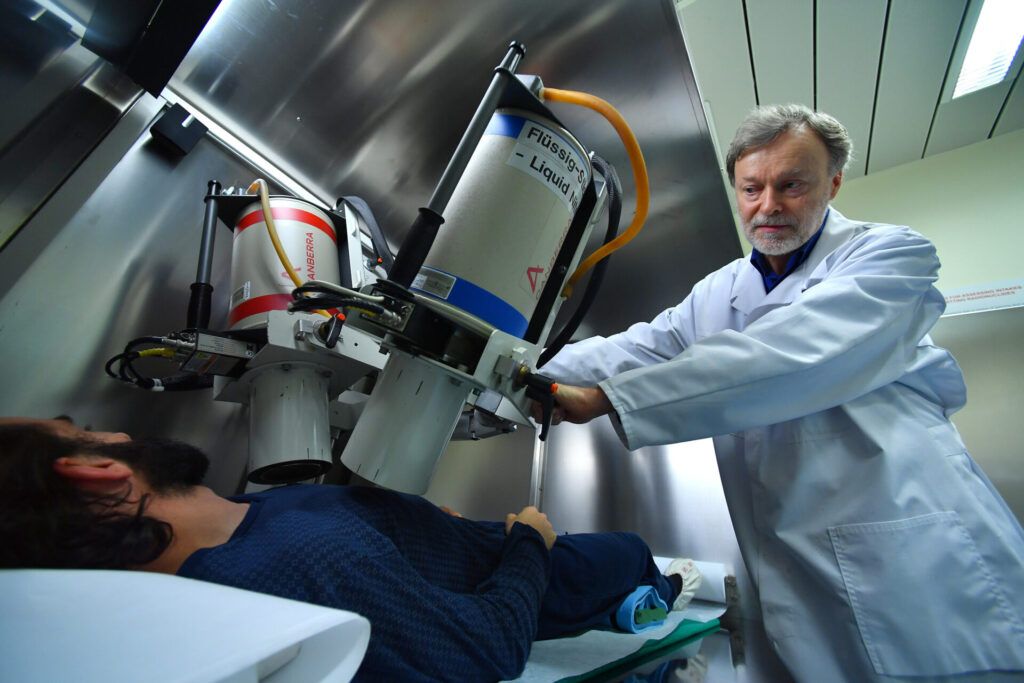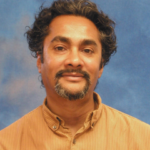Nuclear safety staffing in the United States: a crisis with no easy fix
By David Gillum, Itty Abraham, Kathleen M. Vogel | July 14, 2023
 An in-vivo monitoring of an occupationally-exposed worker at the IAEA radiation monitoring laboratory in Vienna, Austria. The United States currently faces a shortage of radiation safety experts as experienced professionals are reaching retirement age. (Photo credit: Dean Calma / IAEA, via Flickr)
An in-vivo monitoring of an occupationally-exposed worker at the IAEA radiation monitoring laboratory in Vienna, Austria. The United States currently faces a shortage of radiation safety experts as experienced professionals are reaching retirement age. (Photo credit: Dean Calma / IAEA, via Flickr)
According to the International Atomic Energy Agency (IAEA), the UN’s nuclear watchdog, nearly 13 million people are exposed to ionizing radiation in occupational settings every year worldwide. There are horror stories within the nuclear safety community of what can happen with lax institutional oversight of nuclear and radiological materials—from stockpiles of improperly managed radiological waste to missing or inaccurate inventories to lost or destroyed records.
Remedies for such infractions can cost millions of dollars and damage the reputation of institutions. That is why it is essential to have qualified, trustworthy staff and an engaged leadership team overseeing radiation safety within the many academic, governmental, and corporate entities that handle radiological materials.
In the United States, however, three challenges stand in the way of maintaining adequate levels of nuclear safety staffing: an insufficient supply of qualified experts, the loss of established experts, and the loss of tacit knowledge held by experts who retire. No single solution can fix all three challenges. But the loss of experienced personnel and the knowledge they possess should be of highest concern in the medium term.
What a radiation safety officer does. One of the most important responsibilities of a radiation safety officer is to ensure that worker and community radiation doses are kept “as low as reasonably achievable.” Officers must show proof, by measurement or calculation, that a workers’ total annual radiation dosage does not exceed permissible limits. They must maintain dosimetry records and regular reports to prove individuals are working within safe limits and provide this information to workers and regulators upon request.
Radiation safety officers have the authority to stop unsafe and unlicensed radiation activities at an institution and must train anyone who works with or near radiation about its hazards and how to protect themselves and others. Senior radiation safety officers may form part of an institution’s radiation safety committee, which is responsible for reviewing and approving radiation experiments. These professionals are responsible for managing inventories, conducting leak-tests of radiological sources, and assessing radiation-producing equipment. Radiation safety officers must also develop emergency plans, respond to any incident that involves radiation, and be proficient in the rules and regulations governing radiation safety and security.
Radiation safety officers are found in any industry that uses radiation—including agriculture, disinfection and preservation, electrical utilities, health care, home safety, pharmaceuticals, mining operations, space exploration—as well as at academic, government, and research institutions.
Staffing crisis. A recent international review study showed that research funding has increased in industry and commercial applications to support radiopharmaceutical usage in the medical industry, even as a resurgent nuclear power industry would need to hire radiation experts at multiple levels of experience and expertise.
No matter what the future growth of nuclear power is, radiation safety officers will be needed to handle the radioactive waste generated by current and retired reactors. Yet, the pool of radiation protection personnel is already insufficient, increasing competition between private industry and public sectors seeking these highly skilled professionals. At the same time, experienced professionals are reaching retirement age, raising questions about whether an adequate supply of trained professionals will be maintained; who will train the next generation of radiation safety experts; and most important, how embodied expertise will be transmitted to future generations.
Of late, many young professionals and students in radiology-related fields have shifted their career paths, creating a staffing crisis in the radiation safety community. This is partly due to a decrease in funding support for health physics education and training programs. But medical oncology, nuclear engineering, and radiation safety consulting fields also provide opportunities for higher salaries than radiation safety officers generally can command.
Ten years ago, the Health Physics Society, a professional organization for radiation protection specialists, issued a human capital crisis report, identifying a considerable gap between supply and demand for qualified radiation safety professionals in the United States. First identified as a problem in the 1990s, the issue has only gotten worse, with fewer students obtaining radiation-science degrees and more institutions facing challenges with hiring qualified staff to manage radiation safety programs.
Radiation safety officers who began working years ago are retiring. With the “graying out” of older radiation protection workers, there is a dearth of qualified applicants to fill their shoes. Data obtained from the Oak Ridge Institute for Science and Education indicates that since 2009, individuals obtaining bachelor’s degrees in health physics were down 48 percent, master’s degrees were 17 percent lower, and doctorates are at levels similar to 15 years ago. One reason for this trend is tied to career compensation. When a student is considering a future in radiation physics, they can typically choose between going into the health physics field to become a radiation protection worker, or becoming medical physicists—that is, professionals who ensure accuracy, safety, and quality of radiation used in medical procedures. A medical physicist can often command more than double the salary of a health physicist.
Some institutions with less appetite or resources to fill vacant certified radiation protection positions are attempting to capitalize on cross-training and teaching other staff about how to become radiation safety officers. This often consists of having staff attend a 40-hour radiation safety course, followed by lengthy on-the-job shadowing and mentoring from qualified staff members.
The rapid decline in the number of radiation protection specialists is happening too quickly to keep up with the amount of tacit knowledge that needs to be transferred from one generation of professionals to another. For example, knowing how to safely dispose of a gas chromatograph (a device used to separate and then detect the chemical components of a sample mixture to determine their presence or absence) with a sealed radiological source still inside; where to find radiological materials that were used in an experiment decades ago; or how to hunt down specific sources of contamination in a laboratory that uses many different radioisotopes are aspects of a radiation safety officer’s job that may be absent from formal training and documentation. These important tasks require hands-on mentoring.
There are also more complicated skill sets that only a few radiation safety officers are well versed in, such as safeguards and shielding designs for work with plutonium and enriched uranium; mixed field dosimetry for large accelerators; and nuclear criticality safety procedures for preventing uncontrolled nuclear fission chain reactions in reactors. The transfer of this knowledge is of the utmost importance for the future of national and international security.
Benefits and challenges. The benefits from radiation are prodigious and diverse. It is used in medicine to help treat diseases and prolong life, in electronics to test electrical hardware destined for outer space, in food processing to extend the shelf life of meals, in coal-fired power plants to remove toxic chemicals from air stacks, and in many other industries. A variety of research and industry planning efforts anticipate the future growth of radiation applications, including in nuclear power and radiotherapy, which means the need for radiation safety professionals will also increase.
Yet, many factors impact the number of radiation safety professionals needed in the United States, from low salaries for young professionals with health physics degrees to a poor understanding from institutional leadership about the implications of the rapid attrition of qualified personnel.
For the types of radiation labeled as category 1 or 2 by the IAEA, which can cause permanent injury or death within minutes of radiation exposure, US regulations require that an institution have a reviewing official in place. This person makes trustworthiness and reliability determinations regarding who can have unescorted access to extremely dangerous forms of radioactive materials. Access to category 1 or 2 sources requires staff to be fingerprinted and to overcome multiple levels of background checks. While these increased security requirements make sense from a risk-benefit perspective, they can also complicate the everyday management of these materials.
Radiation safety programs typically reside within environmental health and safety departments at most institutions, but their operations are often siloed and not visible to other risk areas, such as biosafety or chemical safety personnel. If institutional leaders are not actively involved in the day-to-day radiation safety operations or do not have clear communication channels, it can be difficult to know whether the oversight of radiation-related dangers are being managed appropriately.
Solutions to the staffing crisis. One obvious way to address the radiation safety officer staffing problem would be to increase the pay of radiation safety officers. Higher salaries could address the supply issue by making it more attractive for students to become radiation safety officers. In addition, there is a need to encourage existing professionals in related fields to consider enrolling in cross-training and supplemental courses leading to professional certification. Cross-training can incentivize more people to acquire radiation safety professional credentials allowing for a deeper bench of professionals to step in when needed. Higher salaries may also help to stem the bleed from existing staffers who are leaving their jobs.
A recent law known as the Chips and Science Act could be a useful mechanism to increase funding for radiation safety professionals in the United States. For example, any institution that receives funding under the act could be required to have at least one radiation safety officer on staff and a contingency plan to address any safety staffing shortfalls. Research funding could also be allocated to academic and research institutions to better document the tacit knowledge of the professionals working in this space.
Other possible solutions involve enlarging the staffing “pipeline” by providing paid internships for students to work in environmental health and safety radiation units; retooling veterans with radiation safety experience; and retraining workers from other relevant domains (including the declining coal and thermal power industries). For instance, Arizona State University is currently initiating a pilot study to retrain professionals with some prior experience in the radiation field in precisely such a manner.
There is also a need for research to better understand these staffing challenges and help design effective solutions. Such efforts range from conducting future-needs surveys and assessments of the effectiveness of retraining efforts to developing a baseline of knowledge required to successfully manage a radiation safety program. Efforts should also focus on collecting and publishing oral histories based on the professional experiences and specific challenges faced by radiation safety officers. Similar to how tacit knowledge was collected for nuclear weapons makers, applied radiation safety research would be useful in better informing current and future policymakers and the radiation safety workforce.
Measures should be taken at a federal level, too. For instance, the US Energy Department could fund a consortium like those focused on non-proliferation activities to prioritize the training of the next generation of radiation safety officers.
Together, we make the world safer.
The Bulletin elevates expert voices above the noise. But as an independent nonprofit organization, our operations depend on the support of readers like you. Help us continue to deliver quality journalism that holds leaders accountable. Your support of our work at any level is important. In return, we promise our coverage will be understandable, influential, vigilant, solution-oriented, and fair-minded. Together we can make a difference.
















